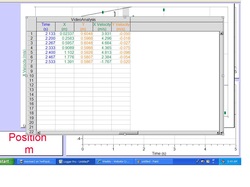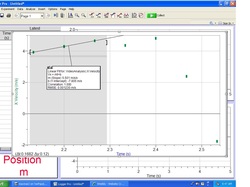Introduction
Background: Newton's Second Law states that acceleration is equal to force divided by mass. In our experiment, we are testing the acceleration of a cart as a result of a hanging mass. The hanging mass is the force in our experiment and the cart is the mass. By conducting this experment, our goal is to determine whether the hanging weight will in fact affect the rate at which the cart travels.
Observations: This lab works by the tester attaching a string the cart and to hanging weight. A barrier is created by anchoring a clamp to a lab bench and attaching a wheel to the clamp in which the string will be looped over so the cart travels in the path of the barrier. The device we are using is a camera that shoots thirty pictures/ second which will allow us to graph data points and determine how fast each cart was accelerating.
Quantities: The measurable quantities in this experiment are the rate of acceleration of the cart (measured in meters per second^2) as different hanging masses (measured in kg) are dropped.
Hypothesis: If the hanging weight from the cart is increased, then the car will accelerate at a faster rate because acceleration is equal to force/mass according to Newton's Second Law.
Observations: This lab works by the tester attaching a string the cart and to hanging weight. A barrier is created by anchoring a clamp to a lab bench and attaching a wheel to the clamp in which the string will be looped over so the cart travels in the path of the barrier. The device we are using is a camera that shoots thirty pictures/ second which will allow us to graph data points and determine how fast each cart was accelerating.
Quantities: The measurable quantities in this experiment are the rate of acceleration of the cart (measured in meters per second^2) as different hanging masses (measured in kg) are dropped.
Hypothesis: If the hanging weight from the cart is increased, then the car will accelerate at a faster rate because acceleration is equal to force/mass according to Newton's Second Law.
Methods
Methods:
In our experiment, the independent variable was the mass of the cart with the small rubber ball placed on top of it. The dependent variable was the hanging weight that we dropped off the table to make the cart accelerate. This changed on evry trial and we started with our heaviest weight of 1000kg and decreased all the way to 50kg. In order to isolate our variable, we kept the height from which we dropped the ball constant. We also kept the weight of the cart constant as well as the position of the ball upon the cart. By keeping these variables constant, we were only testing one variable which indicates that this was a fair test. By only testing this variable we were trying to prove that if you increase the force (which in this lab was the hanging weight), then the thing it is attached to (in our lab it was the cart with the ball resting on it) will accelerate at a faster rate.
1. We began by tightening the clamp to the table and tightening the wheel to the clamp. After this we cut a string that was a little shorter than the length from the lab bench to the floor.
2. Next we tied the string to the cart and looped it over the wheel in order to lessen the friction caused between the string and the clamp as the hanging weight falls to the ground.
3. We then attached different hanging weights to the string each trial and dropped them to the ground while they were attached to the cart. We began with 1000kg and then went to 500kg, 200kg, 100kg, 50kg.
4.This experiment included 5 trials each with a different weight hanging from the string each time. Each time we conducted a trial, we were capturing video of the cart accelerating into the barrier that we created. The shutter speed of the camera was 30 frames per second.
In our experiment, the independent variable was the mass of the cart with the small rubber ball placed on top of it. The dependent variable was the hanging weight that we dropped off the table to make the cart accelerate. This changed on evry trial and we started with our heaviest weight of 1000kg and decreased all the way to 50kg. In order to isolate our variable, we kept the height from which we dropped the ball constant. We also kept the weight of the cart constant as well as the position of the ball upon the cart. By keeping these variables constant, we were only testing one variable which indicates that this was a fair test. By only testing this variable we were trying to prove that if you increase the force (which in this lab was the hanging weight), then the thing it is attached to (in our lab it was the cart with the ball resting on it) will accelerate at a faster rate.
1. We began by tightening the clamp to the table and tightening the wheel to the clamp. After this we cut a string that was a little shorter than the length from the lab bench to the floor.
2. Next we tied the string to the cart and looped it over the wheel in order to lessen the friction caused between the string and the clamp as the hanging weight falls to the ground.
3. We then attached different hanging weights to the string each trial and dropped them to the ground while they were attached to the cart. We began with 1000kg and then went to 500kg, 200kg, 100kg, 50kg.
4.This experiment included 5 trials each with a different weight hanging from the string each time. Each time we conducted a trial, we were capturing video of the cart accelerating into the barrier that we created. The shutter speed of the camera was 30 frames per second.
Percent Error calculation: When fitting a line through our data the lime that we fit throgh our data was almost exactly on our points. The slope of our line was 5.501 plus or minus .02. We performed our calulation by doing .02/5.501 and multiplied the product by 100. After calulating that percent we determined that we had a 36% error.
Results
The meaning of the equation that we determined from our graph is that the cart did in fact accelerate as a result of the increased hanging weight that we dropped from the land bench. Our hypothesis, which was derived from the meaning of Newton's Second Law, was that as the hanging weight that is attached to the cart increases, the acceleration of the cart will also increase. We found this to be true because according to Isaac Newton the acceleration is equal to force/ mass and by increasing the hanging mass we were increasing the force acting upon the cart which has a constant weight of 495.2 grams. Although we were correct, further invesitgations should most likely be conducted because our percent error was too high to consider our data and graphs as 100% believable. In order to ensure more accurate data there are a few things that I would do. One improvement that could be made is to use a camera with a faster shutter speed. The camera that we used was shooting 30 frames per second; a faster camera would provide a more clear picture. A major source of error is that we had to attempt to do our best with the the 30 fps cameras and therefore did not get the clearest data when attempting to plot our data points in logger pro. Another adjustment we could make is to use a heavier cart. The use of a heavier cart would benefit our results significantly. One is that the cart would travel at slower rate given the fact that we use the same hanging weights as we did initially. If the cart was heavier and traveling at a slower rate then it would be easier to capture a video using the 30 frames per second cameras and to graph data points on logger pro.By making these changes we could be able to decrease our 36 percent error to a number that would further support our hypothesis, but overall, we were still able to prove our hypothesis correct by condcuting this experiment that proved Newton's Second Law to be correct.


